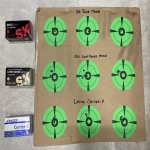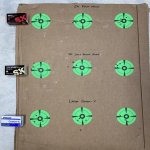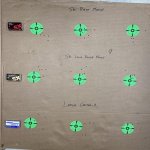I have to disagree with "the chamber thing". A competently reamed "match" chamber doesn't care what brand of ammo is fed into it. A good barrel that is properly tuned shoots good lots of ammo very well. When you forego the tuner, good lots of ammo can shoot poorly, and this is simply due to incompatibility of the load to the naked barrel. It cannot be assumed that "good" ammo, like Center-X, will shoot well in a random, naked barrel rifle. That particular lot may not perform well, either because it is a poor lot or as previously mentioned, it does not suit the barrel. If one were to test 2-3 dozen lots of Center-X, surely at least one of them will give excellent performance. Yet, such availability of ammo is not so generously afforded to us here in Canada, so, "you pays your money and you take your chances".
You are using an out of date browser. It may not display this or other websites correctly.
You should upgrade or use an alternative browser.
You should upgrade or use an alternative browser.
Ruger American Rimfire Long Range Target
- Thread starter TheWhole9Yards
- Start date
PS would love to see the average group comparison between the SK RM and LR at distances from 250yds to 300yds. Thanks
Me too! But I think the temps will dip too much by the time I can get out to a spot to shoot that far. I will try to get some chrono data asap tho.
Mystic Precision
CGN Ultra frequent flyer
- Location
- Summerland, BC
Me too! But I think the temps will dip too much by the time I can get out to a spot to shoot that far. I will try to get some chrono data asap tho.
Yep, temps are starting to dip here too. Just enjoy the rifle and maybe test some HV stuff for closer in practise and fun... unless of course, you want to try some Biathlon ammo?
Your set up is showing alot of promise... and I am actually surprised given some lack luster results from other Factory Ruger rifles.
Looks like you got a good one... Enjoy
Jerry
Jerry, if you prefer not to attempt to answer the questions raised in my previous post (#60), it's understandable. With hindsight, you probably see that your assumptions were not sound.
An ammo that shoots better than another at 50 yards will also do better at 100. And an ammo that does better than another at 100 will also do better at even longer distances. No .22LR ammo -- even the most expensive match ammo -- is gyroscopically self-correcting and can improve it's performance as it travels further downrange.
The chamber issue has been addressed above.
Regarding the suggestion that a shooter can "set up the barrel for CenterX" so that it "shoots very very well," there's no way to match a barrel to a variety of ammo that doesn't involve rechambering it with a chamber designed specifically for a certain make of ammo such as Lapua -- hardly a practical step for shooters of rifles with factory barrels. If that's the "setting up" method you recommend, would it mean that all lots of Center X would shoot equally well?
An ammo that shoots better than another at 50 yards will also do better at 100. And an ammo that does better than another at 100 will also do better at even longer distances. No .22LR ammo -- even the most expensive match ammo -- is gyroscopically self-correcting and can improve it's performance as it travels further downrange.
The chamber issue has been addressed above.
Regarding the suggestion that a shooter can "set up the barrel for CenterX" so that it "shoots very very well," there's no way to match a barrel to a variety of ammo that doesn't involve rechambering it with a chamber designed specifically for a certain make of ammo such as Lapua -- hardly a practical step for shooters of rifles with factory barrels. If that's the "setting up" method you recommend, would it mean that all lots of Center X would shoot equally well?
Last edited:
This is a great option if you want a good turn key match rifle for under $1000. I like that it falls into production for NRS
Thanks for continuing to feed us updates on this rifle. I'm impressed with what you've done with it, and even more with how you've handled the naysayers and de-railers. Good work Sir.
Jerry, my curiosity is piqued and a few questions come to mind.
How does a shooter "set up the barrel for Center X" to get it to shoot "very very well"? What steps are involved?
I think Jerry is referring to the manufacturer of barrels/actions designing and cutting chambers specially with that brand of ammunition in mind. Voodoo is one company I am aware of that does this. Jerry did not imply a shooter could set up their barrel for center-x after the fact.
I think Jerry is referring to the manufacturer of barrels/actions designing and cutting chambers specially with that brand of ammunition in mind. Voodoo is one company I am aware of that does this. Jerry did not imply a shooter could set up their barrel for center-x after the fact.
Indeed, he may have been thinking of the Vudoo repeater, which is supposed to have chamber dimensions often associated with Lapua ammo in general, that is .605" in length (diameter not available) and a 1.5 degree leade. It is not made for any specific variety of Lapua standard .22LR rifle ammo because that ammo is made to the same dimensions.
Jerry responded to an observation by a disappointed poster who thought that Center X "was to be the gold standard" by saying "When you set up the barrel for CenterX, it shoots very very well." He left it at that without saying that the generic "you" was in reference to a gunsmith or a custom made barrel with a specific chamber.
A less well-informed reader than yourself may have taken the words he used to mean that there may be a process or way of literally setting up the barrels discussed in this thread for a specific variety of Lapua ammo. There is no process or method for the shooter at home to modify the barrel for a certain make of ammo that doesn't include rechambering.
A less well-informed reader than yourself may have taken the words he used to mean that there may be a process or way of literally setting up the barrels discussed in this thread for a specific variety of Lapua ammo.
Your nit-picking in this thread is exhausting, for the unlikely possibility that someone interprets something wrong here, there is a far more likely possibility that people who have genuine questions about what we’re discussing will not speak up for fear of you giving a digital lecture on how asking a question could lead a new shooter to... you get the idea.
Policing threads like this must be tiring, please take a break.
Your nit-picking in this thread is exhausting, for the unlikely possibility that someone interprets something wrong here, there is a far more likely possibility that people who have genuine questions about what we’re discussing will not speak up for fear of you giving a digital lecture on how asking a question could lead a new shooter to... you get the idea.
Policing threads like this must be tiring, please take a break.
Yup, Karen of the gun world.
I can understand the various opinions and answers and why some shooters here express their frustrations.
I don’t think anyone should take it personally. I just find the serious rimfire shooters take it very seriously because they have a lot more variables than what a centerfire shooter has to go through. Most of these guys have mastered tight groups with their center fires but are still chasing the “holy grail” of consistent accuracy.
They have no control over the ammo which makes the difficulty at an extreme.
So you buy a brick of ammo and it’s the best your rifle has ever shot so you go buy more only to find that it’s a different lot number and doesn’t shoot well anymore. Very frustrating.
When statements are made about sub MOA all day long I’m sure it’s not said to purposely cause problems, but the serious shooter demands results because that is a bold statement.
It’s also hard for anyone to believe that a factory Ruger could shoot sub MOA at 100yds, and I know the OP said 50 but the serious folk want to see 100yd results.
On a side note can the barrel be removed easily like a 10/22 so that a aftermarket barrel can be installed?
I don’t think anyone should take it personally. I just find the serious rimfire shooters take it very seriously because they have a lot more variables than what a centerfire shooter has to go through. Most of these guys have mastered tight groups with their center fires but are still chasing the “holy grail” of consistent accuracy.
They have no control over the ammo which makes the difficulty at an extreme.
So you buy a brick of ammo and it’s the best your rifle has ever shot so you go buy more only to find that it’s a different lot number and doesn’t shoot well anymore. Very frustrating.
When statements are made about sub MOA all day long I’m sure it’s not said to purposely cause problems, but the serious shooter demands results because that is a bold statement.
It’s also hard for anyone to believe that a factory Ruger could shoot sub MOA at 100yds, and I know the OP said 50 but the serious folk want to see 100yd results.
On a side note can the barrel be removed easily like a 10/22 so that a aftermarket barrel can be installed?
Jerry, if you prefer not to attempt to answer the questions raised in my previous post (#60), it's understandable. With hindsight, you probably see that your assumptions were not sound.
An ammo that shoots better than another at 50 yards will also do better at 100. And an ammo that does better than another at 100 will also do better at even longer distances. No .22LR ammo -- even the most expensive match ammo -- is gyroscopically self-correcting and can improve it's performance as it travels further downrange.
The chamber issue has been addressed above.
Regarding the suggestion that a shooter can "set up the barrel for CenterX" so that it "shoots very very well," there's no way to match a barrel to a variety of ammo that doesn't involve rechambering it with a chamber designed specifically for a certain make of ammo such as Lapua -- hardly a practical step for shooters of rifles with factory barrels. If that's the "setting up" method you recommend, would it mean that all lots of Center X would shoot equally well?
Jerry is correct - with my 17 hmr my 100 yard 5 shot groups were about 1.25 inches at 200 yards my 5 shot group was just over 1.50 inches - you would think that at 200 yards my groups should have been just under 3 inches - I am sure the same theory will hold true with 22 lr ammo -
Jerry is correct - with my 17 hmr my 100 yard 5 shot groups were about 1.25 inches at 200 yards my 5 shot group was just over 1.50 inches - you would think that at 200 yards my groups should have been just under 3 inches - I am sure the same theory will hold true with 22 lr ammo -
Depending on the type of target used there's a chance of a bit more slop in the size of the bullseye closer up, while at half the size the exact aim is a bit more distinct.
Your nit-picking in this thread is exhausting, for the unlikely possibility that someone interprets something wrong here, there is a far more likely possibility that people who have genuine questions about what we’re discussing will not speak up for fear of you giving a digital lecture on how asking a question could lead a new shooter to... you get the idea.
Policing threads like this must be tiring, please take a break.
As long as you're happy to have misinformation and defend it that will always remain your perogative. No better example of misinformation in this thread is the idea that some ammos shoot better at longer distances than at closer ones.
An ammo that shoots better than another at 50 yards will also do better at 100. And an ammo that does better than another at 100 will also do better at even longer distances. No .22LR ammo -- even the most expensive match ammo -- is gyroscopically self-correcting and can improve it's performance as it travels further downrange.
You are 100% incorrect. There are plenty of rimfire ammunition types that perform better the farther out you push them. You just need to test ammunition types more than you test your keyboard.
You are 100% incorrect. There are plenty of rimfire ammunition types that perform better the farther out you push them. You just need to test ammunition types more than you test your keyboard.
Are you familiar with geometry? How on earth can a .22LR ammo produce 1 MOA at 200 yards if it can't at 100?
Last edited:
There are a few examples of centre fires that are less accurate (average group) at shorter ranges than they are at longer ones. 303 Brit from a No1 is likely to have poor accuracy at 100m, sightly better at 200 and then steady and better accuracy from 300-600. Generally it's put down to stability issues in the projectile at closer ranges, which settles down as it continues down range. I've seen high speed film of tank guns where it takes the round a surprising amount of time to "settle down" and fly in a more stable manner.
- Location
- Southern Vancouver Island
There are a few examples of centre fires that are less accurate (average group) at shorter ranges than they are at longer ones. 303 Brit from a No1 is likely to have poor accuracy at 100m, sightly better at 200 and then steady and better accuracy from 300-600. Generally it's put down to stability issues in the projectile at closer ranges, which settles down as it continues down range. I've seen high speed film of tank guns where it takes the round a surprising amount of time to "settle down" and fly in a more stable manner.
Agreed for the .303 Mk VII rounds that I've pounded out through many LE's over the years. They be unstable at high speed due to the light nose section of the bullet. When the bullet got out at sufficient distance to slow down to speeds they would be more stable due to less rotational force on the projectile.
These were made this way to tumble upon impact to create a large wound channel compared to rounds like the 8x57 & such back around WW1.
I poked a bunch of Dominion Arsenal Mk VII's though an amigo's Ross M10 and observed similar results. Groups at 200 yds weren't smaller than at 100,
but they were more uniform. Normal hunting & target bullets shot tighter at 100 yds due to more centralized balance and uniform construction compared to the bullet that dropped the Red Baron.
Last edited:
Attachments
Might be throwing gas on this dumpster fire of a thread but here it goes, groups described in my earlier post - where the avg group size data came from.
51Yards
View attachment 424315
106Yards
View attachment 424316
186Yards
View attachment 424317
Thank you for posting. Same ammo from 50 to 186 with the same rifle is a breadth of data usually not posted together.












































































